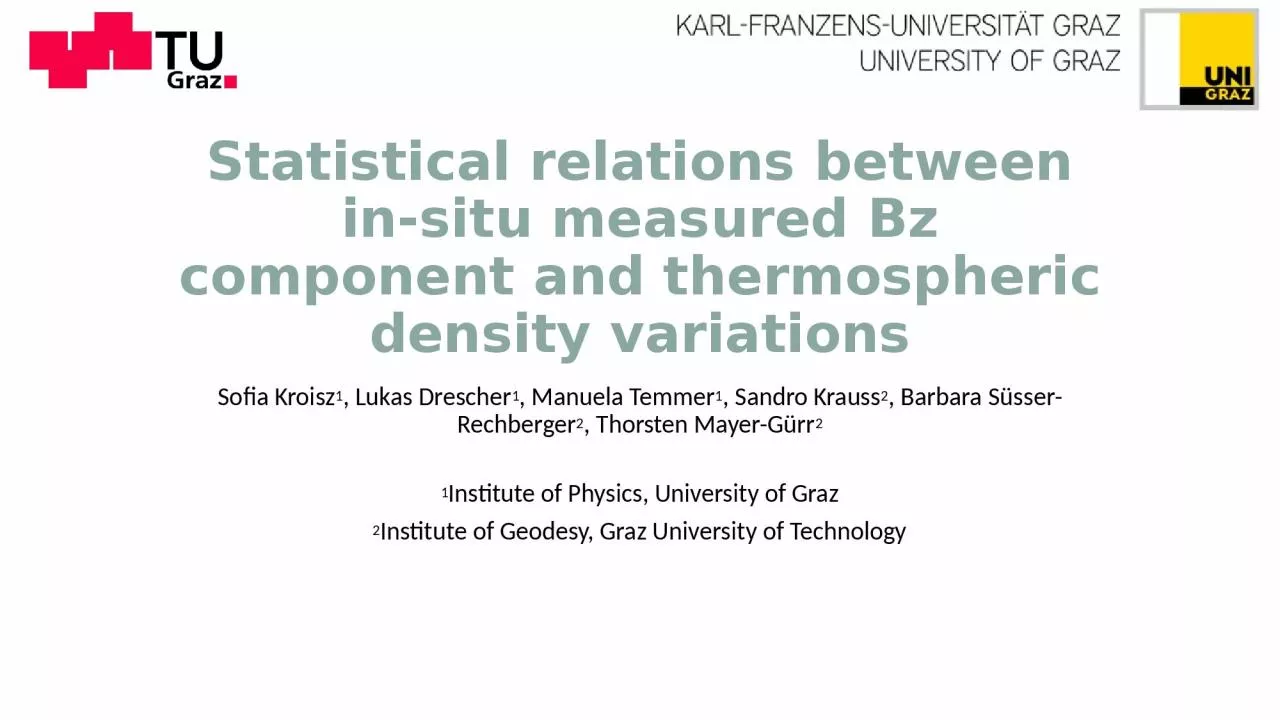

Bz component and thermospheric density variations Sofia Kroisz 1 Lukas Drescher 1 Manuela Temmer 1 Sandro Krauss 2 Barbara SüsserRechberger 2 Thorsten MayerGürr 2 1 ID: 934537
Download Presentation The PPT/PDF document "Statistical relations between in-situ me..." is the property of its rightful owner. Permission is granted to download and print the materials on this web site for personal, non-commercial use only, and to display it on your personal computer provided you do not modify the materials and that you retain all copyright notices contained in the materials. By downloading content from our website, you accept the terms of this agreement.
Slide1
Statistical relations between in-situ measured Bz component and thermospheric density variations
Sofia Kroisz1, Lukas Drescher1, Manuela Temmer1, Sandro Krauss2, Barbara Süsser-Rechberger2, Thorsten Mayer-Gürr21Institute of Physics, University of Graz2Institute of Geodesy, Graz University of Technology
Slide2Project SWEETS Forecasting Space Weather Effects on low Earth orbiting satellitesThe project focuses on the development of a forecasting model, to predict the expected impact of solar events on satellites at different altitudes. The basis for the forecasting are real-time measurements of solar wind plasma and magnetic field data from satellites at the Lagrange point L1 (ACE, Wind, DSCOVR). For the background statistics we used the magnetic component Bz of 300 CME events, in a time range from April 2002 to May 2017. For the identification of the events, we relied on the list from Richardson & Cane. The Bz
component was measured with the ACE spacecraft, located at the Lagrange point L1, with a resolution of 4 minutes.
https://www.tugraz.at/institute/ifg/projects/theoretical-geodesy-and-satellite-geodesy/sweets
/
See also:
Slide3Calculation of density variations and orbit decay
More details => EGU21-4174: „Current status of project SWEETS: Estimating thermospheric neutral mass
densities from satellite data at
various
altitudes
by
Krauss et. al“.
The neutral mass densities and orbit decays for the statistical analysis are calculated preliminary with kinematic orbit information and accelerometer measurements, onboard of the GRACE space mission at an altitude of 490km.
Slide4Statistical analysis
We have statistically analyzed the correlation of the density variations or orbit decay with the magnetic field Bz component and interpolated a linear regression curve. In addition, all events were examined individually and assigned to one of three categories. The categories are defined as follows:
Over 48h: single event, time between two events is > 48h
Under 48h: single Event, but the temporal distance is over 24h and under 48h
Under 24h: multiple events, as the time between two or more events is less then 24h
Slide5SODA – Satellite Orbit DecAyThe derived statistical relations are used to develop a near-real time forecasting model, to estimate a possible orbit decay induced by space weather storms. Not yet included are the time shift between the arrival of an event and time of maximum orbit decay and the duration time of an CME event, which gives enough room for improvement of the model.
For a demonstrator version see: https://swe.uni-graz.at/index.php/services/nd-forecast
Slide6ReferencesKrauss et. al., 2018. Multiple satellite analysis of the Earth's thermosphere and interplanetary magnetic field variations due to ICME/CIR events during 2003–2015. Journal of Geophysical Research: Space Physics, 123(10), 8884-8894.Krauss et. al., 2020. Exploring Thermospheric Variations Triggered by Severe Geomagnetic Storm on 26 August 2018 Using GRACE Follow‐On Data. Journal of Geophysical Research: Space Physics
, 125(5), e2019JA027731.Richardson & Cane, http://www.srl.caltech.edu/ACE/ASC/DATA/level3/icmetable2.htm#